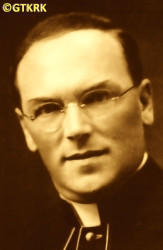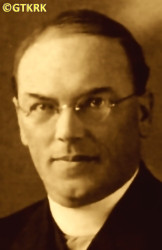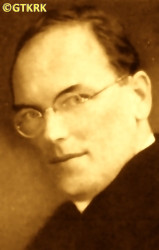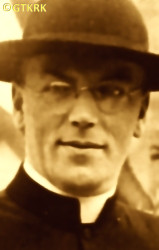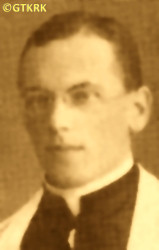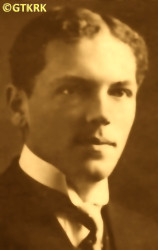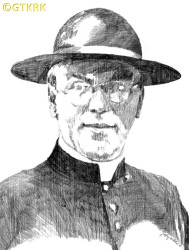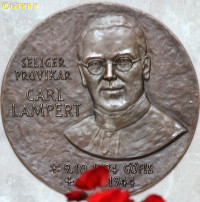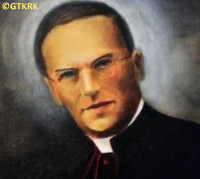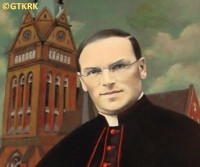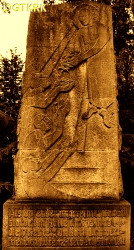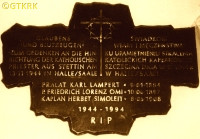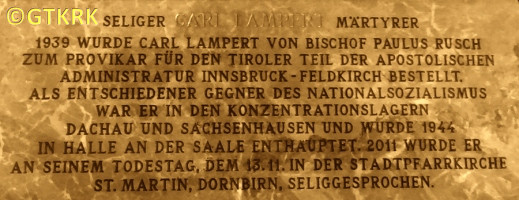Roman Catholic
St Sigismund parish
05-507 Słomczyn
85 Wiślana Str.
Konstancin deanery
Warsaw archdiocese, Poland
full list:
displayClick to display full list

searchClick to search full list by categories
wyświetlKliknij by wyświetlić pełną listę po polsku

szukajKliknij by przeszukać listę wg kategorii po polsku

Martyrology of the clergy — Poland
XX century (1914 – 1989)
personal data
religious status
blessed
surname
LAMPERT
forename(s)
Charles (pl. Karol)
forename(s)
versions/aliases
Karl
function
diocesan priest
creed
Latin (Roman Catholic) Church RCmore on
en.wikipedia.org
[access: 2014.09.21]
diocese / province
Berlin diocesemore on
en.wikipedia.org
[access: 2013.12.04]
Apostolic Administration of Innsbruck‐Feldkirchmore on
www.catholic-hierarchy.org
[access: 2021.12.19]
Brixen diocesemore on
en.wikipedia.org
[access: 2019.04.16]
academic distinctions
Doctor of Canon Law
honorary titles
pontifical prelatemore on
pontifical prelate
(1935)
nationality
Austrian
date and place
of death
13.11.1944

Halle an der Saaleform.: Dobrogóra
today: Halle (Saale), Halle (Saale) dist., Saxony‐Anhalt state, Germany
more on
en.wikipedia.org
[access: 2022.08.05]
details of death
After German and Russian invasion of Poland in 09.1939 and start of the World War II arrested by the Austrians/Germans for the first time on 04.03.1940 — for open criticism of German regime and protest against robbery of a monastery in Innsbruck by national–socialist rulers of Austria.
Released on 14.03.1940.
Arrested again on 25.08.1940 — after making the Innsbruck monastery's robbery public through Vatican radio and after publishing obituary of Fr Otto Neururer, murdered by the Germans, in a parish newsletter — and transported to KL Dachau concentration camp.
On 01.09.1940 taken to KL Sachsenhausen concentration camp where was forced to slave work.
On 14‐15.12.1940 transported back to KL Dachau.
Released on 01.08.1941 as a result of Catholic Church intervention, but forbidden to return to his Innsbruck–Feldkirch Apostolic Administration.
On 16.08.1941 moved to Szczecin invited by Berlin diocese bishop.
Finally on 04‐05.02.1943 in Szczecin arrested by the Germans for the last time, during „Fall Stettin” — action aimed at Catholic clergy — together with Fr Albert Hirsch, Fr Frederick Lorenz, Fr Herbert Simoleit and Fr Alphonse Maria Wachsmann (arrested later), among others.
Held in German political police Gestapo prison in Szczecin.
Interrogated numerous times and tortured.
Did not break.
Next brought to a prison in Berlin and from there, on 06.12.1943, transferred to Roter Ochse prison in Halle (Salle) where on 30.12.1943 tried by the highest military court Reichskriegsgericht, together with Fr Frederick Lorenz and Fr Herbert Simoleit, accused of treason and sedition.
Found guilty but the lack of unanimity between the judges — only some voted for death penalty — the sentence was not signed.
On 14.01.1944 sent to German army Wehrmacht prison in Torgau.
For 7 months held in solitary confinement.
On 27.07.1944 tried in Halle again, with the aforementioned priests, and again found guilty.
Before however signing the death sentence during the following night presiding judge, Werner Lueben, committed suicide leaving a note stating that „These are neither 'criminals' nor 'asocial elements'.
Their only tragedy is that they are Catholic priests!” Finally on 08.09.1944 in Torgau sentenced to death — for the third time.
On 10.11.1944 brought to Roter Ochse prison in Halle and beheaded, together with two aforementioned priests.
alt. details of death
According to some sources beheaded c. a week later.
prisoner camp's numbers
22706Click to display source page (KL DachauClick to display the description)
cause of death
mass murder
perpetrators
Germans
sites and events
Fall StettinClick to display the description, KL DachauClick to display the description, KL SachsenhausenClick to display the description, Ribbentrop‐MolotovClick to display the description, Pius XI's encyclicalsClick to display the description
date and place
of birth
09.01.1894

Göfistoday: Feldkirch dist., Vorarlberg state, Austria
more on
en.wikipedia.org
[access: 2024.03.19]
parents
LAMPERT Francis Xavier
🞲 ?, ? — 🕆 ?, ?

AMMANN Anne Rose
🞲 ?, ? — 🕆 ?, ?
presbyter (holy orders)
ordination
12.05.1918

Brixentoday: Bressanone, South Tyrol prov., Trentino‐Alto Adige/Südtirol reg., Italy
more on
en.wikipedia.org
[access: 2019.04.16]
Assumption of the Blessed Virgin Mary and St Cassian RC cathedral churchmore on
en.wikipedia.org
[access: 2025.03.14]
positions held
1941 – 1943
priest — Szczecintoday: Szczecin city pov., West Pomerania voiv., Poland
more on
en.wikipedia.org
[access: 2021.12.18] ⋄ St John the Baptist RC parish ⋄ Szczecintoday: Szczecin city pov., West Pomerania voiv., Poland
more on
en.wikipedia.org
[access: 2021.12.18] RC deanery
1941 – 1943
chaplain — Szczecintoday: Szczecin city pov., West Pomerania voiv., Poland
more on
en.wikipedia.org
[access: 2021.12.18] ⋄ St Charles Borromeo Hospital
1939 – 1940
vicar general — Innsbruck‐FeldkirchAdministration's name
today: Austria
more on
www.catholic-hierarchy.org
[access: 2022.08.05] ⋄ Apostolic Administration
from 1936
chaplain — Innsbrucktoday: Innsbruck‐Land dist., Tyrol state, Austria
more on
en.wikipedia.org
[access: 2024.03.19] ⋄ Theological Seminary
director — Catholic Publishing House „Tyrolia”
from 1935
vicar — Innsbrucktoday: Innsbruck‐Land dist., Tyrol state, Austria
more on
en.wikipedia.org
[access: 2024.03.19] ⋄ RC parish
till 1935
lawyer — Rometoday: Rome prov., Lazio reg., Italy
more on
en.wikipedia.org
[access: 2021.12.18] ⋄ Lat. „Tribunal Rotae Romanae”, Roman Curia
1930 – 1935
PhD student — Rometoday: Rome prov., Lazio reg., Italy
more on
en.wikipedia.org
[access: 2021.12.18] ⋄ Pontifical Roman German and Hungarian College (Lat. Pontificium Collegium Germanicum et Hungaricum de Urbe), known as „Collegium Germanicum” — resident: Pontifical Teutonic Institute Santa Maria dell' Anima
from 1918
vicar — Dornbirntoday: Dornbirn dist., Vorarlberg state, Austria
more on
en.wikipedia.org
[access: 2022.08.05] ⋄ St Martin the Bishop and Confessor RC parish
1914 – 1918
student — Brixentoday: Bressanone, South Tyrol prov., Trentino‐Alto Adige/Südtirol reg., Italy
more on
en.wikipedia.org
[access: 2019.04.16] ⋄ philosophy and theology, Theological Seminary
others related
in death
HIRSCHClick to display biography Albert, LORENZClick to display biography Frederick, SIMOLEITClick to display biography Herbert, WACHSMANNClick to display biography Alphonse Mary
sites and events
descriptions
Fall Stettin: German action against Catholic church in Szczecin and Pomerania region. Using provocation — among others German political police Gestapo disseminated rumours that Catholic priest allegedly installed broadcasting radio‐station on top the St John the Baptist church steeple and were secretly transmitting information to London — on 04‐05.02.1943 Germans arrested 40 people, including 11 Catholic priests, friars and nuns, accusing them of spying for allies. Some of the arrested were subsequently murdered (including five Catholic priests ‐ four of whom were tried, sentenced to death and beheaded in the prison), the rest were sent to concentration camps. (more on: pl.wikipedia.orgClick to attempt to display webpage
[access: 2013.05.19])
KL Dachau: KL Dachau in German Bavaria, set up in 1933, became the main German Germ. Konzentrationslager (Eng. concentration camp) KL for Catholic priests and religious during World War II: On c. 09.11.1940, Reichsführer‐SS Heinrich Himmler, head of the SS, Gestapo and German police, as a result of the Vatican's intervention, decided to transfer all clergymen detained in various concentration camps to KL Dachau camp. The first major transports took place on 08.12.1940. In KL Dachau Germans held approx. 3,000 priests, including 1,800 Poles. The priests were forced to slave labor in the Germ. „Die Plantage” — the largest herb garden in Europe, managed by the genocidal SS, consisting of many greenhouses, laboratory buildings and arable land, where experiments with new natural medicines were conducted — for many hours, without breaks, without protective clothing, no food. They slaved in construction, e.g. of camp's crematorium. In the barracks ruled hunger, freezing cold in the winter and suffocating heat during the summer, especially acute in 1941‐1942. Prisoners suffered from bouts of illnesses, including tuberculosis. Many were victims of murderous „medical experiments” — in 11.1942 c. 20 were given phlegmon injections; in 07.1942 to 05.1944 c. 120 were used by for malaria experiments. More than 750 Polish clerics where murdered by the Germans, some brought to TA Hartheim euthanasia centre set up in Schloss Hartheim in Austria and murdered in gas chambers. At its peak KL Dachau concentration camps’ system had nearly 100 slave labour sub‐camps located throughout southern Germany and Austria. There were c. 32,000 documented deaths at the camp, and thousands perished without a trace. C. 10,000 of the 30,000 inmates were found sick at the time of liberation, on 29.04.1945, by the USA troops… (more on: www.kz-gedenkstaette-dachau.deClick to attempt to display webpage
[access: 2013.08.10], en.wikipedia.orgClick to attempt to display webpage
[access: 2016.05.30])
KL Sachsenhausen: In Germ. Konzentrationslager (Eng. concentration camp) KL Sachsenhausen, set up in the former Olympic village in 07.1936, hundreds of Polish priests were held in 1940, before being transported to KL Dachau. Some of them perished in KL Sachsenhausen. Murderous medical experiments on prisoners were carried out in the camp. In 1942‐1944 c. 140 prisoners slaved at manufacturing false British pounds, passports, visas, stamps and other documents. Other prisoners also had to do slave work, for Heinkel aircraft manufacturer, AEG and Siemens among others. On average c. 50,000 prisoners were held at any time. Altogether more than 200,000 inmates were in jailed in KL Sachsenhausen and its branched, out of which tens of thousands perished. Prior to Russian arrival mass evacuation was ordered by the Germans and c. 80,000 prisoners were marched west in so‐called „death marches” to other camps, i.e. KL Mauthausen‐Gusen and KL Bergen‐Belsen. The camp got liberated on 22.04.1945. After end of armed hostilities Germans set up there secret camp for German prisoners and „suspicious” Russian soldiers. (more on: en.wikipedia.orgClick to attempt to display webpage
[access: 2018.11.18])
Ribbentrop‐Molotov: Genocidal Russian‐German alliance pact between Russian leader Joseph Stalin and German leader Adolf Hitler signed on 23.08.1939 in Moscow by respective foreign ministers, Mr. Vyacheslav Molotov for Russia and Joachim von Ribbentrop for Germany. The pact sanctioned and was the direct cause of joint Russian and German invasion of Poland and the outbreak of the World War II in 09.1939. In a political sense, the pact was an attempt to restore the status quo ante before 1914, with one exception, namely the „commercial” exchange of the so‐called „Kingdom of Poland”, which in 1914 was part of the Russian Empire, fore Eastern Galicia (today's western Ukraine), in 1914 belonging to the Austro‐Hungarian Empire. Galicia, including Lviv, was to be taken over by the Russians, the „Kingdom of Poland” — under the name of the General Governorate — Germany. The resultant „war was one of the greatest calamities and dramas of humanity in history, for two atheistic and anti‐Christian ideologies — national and international socialism — rejected God and His fifth Decalogue commandment: Thou shall not kill!” (Abp Stanislav Gądecki, 01.09.2019). The decisions taken — backed up by the betrayal of the formal allies of Poland, France and Germany, which on 12.09.1939, at a joint conference in Abbeville, decided not to provide aid to attacked Poland and not to take military action against Germany (a clear breach of treaty obligations with Poland) — were on 28.09.1939 slightly altered and made more precise when a treaty on „German‐Russian boundaries and friendship” was agreed by the same murderous signatories. One of its findings was establishment of spheres of influence in Central and Eastern Europe and in consequence IV partition of Poland. In one of its secret annexes agreed, that: „the Signatories will not tolerate on its respective territories any Polish propaganda that affects the territory of the other Side. On their respective territories they will suppress all such propaganda and inform each other of the measures taken to accomplish it”. The agreements resulted in a series of meeting between two genocidal organization representing both sides — German Gestapo and Russian NKVD when coordination of efforts to exterminate Polish intelligentsia and Polish leading classes (in Germany called «Intelligenzaktion», in Russia took the form of Katyń massacres) where discussed. Resulted in deaths of hundreds of thousands of Polish intelligentsia, including thousands of priests presented here, and tens of millions of ordinary people,. The results of this Russian‐German pact lasted till 1989 and are still in evidence even today. (more on: en.wikipedia.orgClick to attempt to display webpage
[access: 2015.09.30])
Pius XI's encyclicals: Facing the creation of two totalitarian systems in Europe, which seemed to compete with each other, though there were more similarities than contradictions between them, Pope Pius XI issued in 03.1937 (within 5 days) two encyclicals. In the „Mit brennender Sorge” (Eng. „With Burning Concern”) published on 14.03.1938, condemned the national socialism prevailing in Germany. The Pope wrote: „Whoever, following the old Germanic‐pre‐Christian beliefs, puts various impersonal fate in the place of a personal God, denies the wisdom of God and Providence […], whoever exalts earthly values: race or nation, or state, or state system, representatives of state power or other fundamental values of human society, […] and makes them the highest standard of all values, including religious ones, and idolizes them, this one […] is far from true faith in God and from a worldview corresponding to such faith”. On 19.03.1937, published „Divini Redemptoris” (Eng. „Divine Redeemer”), in which criticized Russian communism, dialectical materialism and the class struggle theory. The Pope wrote: „Communism deprives man of freedom, and therefore the spiritual basis of all life norms. It deprives the human person of all his dignity and any moral support with which he could resist the onslaught of blind passions […] This is the new gospel that Bolshevik and godless communism preaches as a message of salvation and redemption of humanity”… Pius XI demanded that the established human law be subjected to the natural law of God , recommended the implementation of the ideal of a Christian state and society, and called on Catholics to resist. Two years later, National Socialist Germany and Communist Russia came together and started World War II. (more on: www.vatican.vaClick to attempt to display webpage
[access: 2023.05.28], www.vatican.vaClick to attempt to display webpage
[access: 2023.05.28])
sources
personal:
niedziela.plClick to attempt to display webpage
[access: 2012.11.23], pl.wikipedia.orgClick to attempt to display webpage
[access: 2013.05.19]
original images:
encyklopedia.szczecin.plClick to attempt to display webpage
[access: 2019.04.16], gs24.plClick to attempt to display webpage
[access: 2019.04.16], www.kath-kirche-vorarlberg.atClick to attempt to display webpage
[access: 2019.04.16], www.kath-kirche-vorarlberg.atClick to attempt to display webpage
[access: 2019.04.16], commons.wikimedia.orgClick to attempt to display webpage
[access: 2019.04.16], www.kath-kirche-vorarlberg.atClick to attempt to display webpage
[access: 2019.04.16], www.kulturzeitschrift.atClick to attempt to display webpage
[access: 2019.04.16], bilder.tibs.atClick to attempt to display webpage
[access: 2019.04.16], dzieje.plClick to attempt to display webpage
[access: 2019.04.16], m.niedziela.plClick to attempt to display webpage
[access: 2019.04.16], commons.wikimedia.orgClick to attempt to display webpage
[access: 2019.04.16], docplayer.orgClick to attempt to display webpage
[access: 2019.04.16], pl.wikipedia.orgClick to attempt to display webpage
[access: 2013.12.04], www.flickr.comClick to attempt to display webpage
[access: 2019.04.16]
LETTER to CUSTODIAN/ADMINISTRATOR
If you have an Email client on your communicator/computer — such as Mozilla Thunderbird, Windows Mail or Microsoft Outlook, described at WikipediaPatrz:
en.wikipedia.org, among others — try the link below, please:
LETTER to CUSTODIAN/ADMINISTRATORClick and try to call your own Email client
If however you do not run such a client or the above link is not active please send an email to the Custodian/Administrator using your account — in your customary email/correspondence engine — at the following address:

giving the following as the subject:
MARTYROLOGY: LAMPERT Charles
To return to the biography press below:
 Click to return to biography
Click to return to biography








